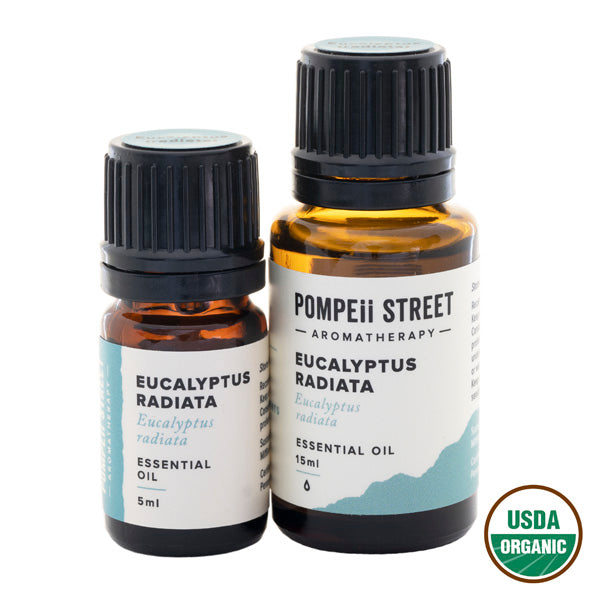Eucalyptus is historically known for helping sinuses, cold and flu, muscle aches and pains, and headaches. Why is that? It is due to a molecule named 1,8 cineole (pronounced “one eight ˈsin-ē-ˌōl”), commonly called Eucalyptol. The most common 1,8 cineole-rich eucalyptus species are globulus and radiata, but include the following as well: smithii, plenissima, polybractea, camaldulensis, and maidenii, just to name a few.
1,8 cineole is a superstar molecule, responsible for the following well researched benefits:
- Decongestive and Mucolytic - softens mucous and clears congestion
- Expectorant - helps to expel mucous from the respiratory system
- Anti-inflammatory - calms inflammation
- Antispasmodic - relieves muscle tightness in cases of spasmodic coughing and muscle spasms
- Encourages circulation
- Disinfects the sinuses
Many other essential oils contain 1,8 cineole:
| Oil | % of 1,8 Cineole | Notes |
| Eucalyptus (globulus) | 68.34% | |
| Eucalyptus (radiata) | 68.17% | |
| Rosemary (Rosmarinus officinalis ct 1,8 cineole) | 45.76% | |
| Bay Laurel (Laurus nobilis) | 46.99% | |
| Cardamom (Elettaria cardamomum) | 31.79% | Oils with lower levels of 1,8 cineole are recommended for older children and elderly. See safety notes below. |
| Fragonia (Agonis fragrans) | 29.22% | |
| Rosalina (Melaleuca ericifolia) | 15.44% | |
| Yarrow (Achillea millefolium) | 6.07% | |
| Percentages of 1,8 cineole content listed above are averages calculated from gc/ms reports 2013-2020. Always refer to batch specific reports when making decisions for therapeutic formulating. Source: https://pompeiistreet.com/gc-ms-archive/ | ||
What is the difference between Eucalyptus radiata and globulus ?
This is one of the most frequently asked questions at our store. I have broken it down to aroma, chemistry, skin, and sourcing.
Aroma - The aromas of these two oils are very different. You can definitely notice the medicinal eucalyptol dominance of each, but what sets radiata apart are the supporting fruity notes.Upon opening a fresh bottle of radiata, I am immediately overcome with notes of sweet florals and fruits, almost as though someone dropped eucalyptus in a bowl of fresh mangos and apricots. If you are familiar with parcha (passion fruit), this is in there, too. Radiata smells complex and soulful, as if it is a blend of different oils, but it’s not. It is simply awesome on its own. It may just be a personal preference but I find radiata to smell best in small amounts. Keep in mind that a little goes a long way and it can easily dominate a blend.
Chemistry - Sourcing oils directly from distillers for so many years has given us multiple chemistry reports to compare Eucalyptus globulus and radiata. It was a big surprise to learn that they both averaged approximately 68% 1,8 cineole. After learning this similar chemistry, the next was to explore the differences. Looking into the chemistry of the oil further, we find that globulus tends to be a one trick pony (almost entirely oxides with some monoterpenes), while radiata features the addition of monoterpenols (alpha-terpineol, specifically) and small percentages of other chemical families. This makes radiata a more well-rounded oil with additional benefits of being skin friendly, having a slightly more stable shelf life, and smelling less medicinal than globulus.
Skin - When using radiata for a topical blend, the extra monoterpenol content makes it a more skin-friendly option. This is helpful to know when making topical respiratory blends such as chest rubs for coughs or headache roll-ons, especially for those with sensitive skin.
Processing and Sourcing - Radiata is generally not ‘messed with’. It is single distilled, keeping its chemistry closer to what the original plant encompassed. Globulus is often redistilled (rectified) to achieve a higher 1,8 cineole content. During the multiple distillation processes, many other natural components are removed. In aromatherapy, we like the diversified components in essential oils. If that particular synergy worked for the plant, it is believed to be effective in the oil.
SAFETY & USAGE
Do not use essential oils near infants. It is not recommended to use 1,8 cineole rich oils on or around young children. Use extreme caution with asthmatics as the opposite effects may occur. Use oils within peak freshness to avoid skin irritation, sensitization, or potential headaches.
Alternative respiratory health oils for children and elderly include Frankincense, Cedarwood, and Rosalina. Also consider blending Eucalyptus Radiata with skin friendly oils to achieve a lower 1,8 cineole content in your blend.
USAGE RECOMMENDATIONS
Steam Inhalation - place just one single drop of Eucalyptus Radiata or other oxide-rich oil in a small mug with hot water (steaming). Cover your head with a towel, close your eyes, and breathe deeply for 15 minutes. This will help clear your sinuses and prevent infection.
Ultrasonic Diffuser - clear the air and support respiratory health by adding just 3 to 5 drops to an ultrasonic diffuser.
Chest Rub - place 15-20 drops of Eucalyptus Radiata into a 1 oz glass jar with slightly melted organic shea butter and mix well. Allow to cool completely. Rub onto chest for long lasting respiratory support. This can also be used as a rub for tight muscles.
RESOURCES
Butje, A. The Heart of Aromatherapy: An Easy-to-use Guide for Essential Oils . United States: Hay House, 2017.
Rhind J. Essential Oils: A Handbook for Aromatherapy Practice. 2 nd Edition. United States: Singing Dragon, 2012.
Tisserand R. and Young R. Essential Oil Safety: A Guide for Healthcare Professionals. 2 nd Edition. United Kingdom: Churchill Livingstone Elsevier, 2013.
For educational purposes only. This information has not been evaluated by the Food and Drug Administration. This information is not intended to diagnose, treat, cure, or prevent any disease. Consult a licensed healthcare professional before administering essential oils.

